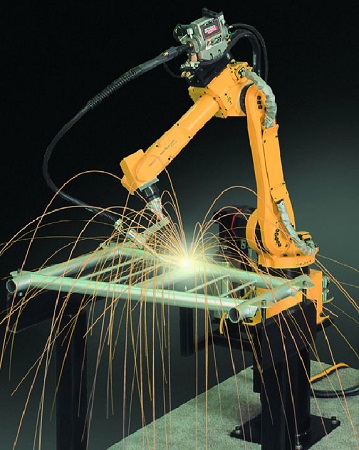By Gregory Havel
One of the most common connections used today in structural steel fabrication and erection is arc welding. The strength of these connections depends on good metal-to-metal contact; the cleanliness of the metal surfaces; the proper size and alloy of the welding electrode or wire; the proper amperage (electric current); proper size of the finished weld, which may require more than one pass by the welder; the proper technique; and the skill of the welder. A skillfully executed weld will have the same or greater strength than the steel parts that it connects.
Photo 1 shows two tubular beams that have been welded to an H-column. The white paint has been ground from the steel in the areas to be welded and will be replaced when welding has been completed, inspected, and approved. The welding on the beam on the right has been completed, and it required multiple passes by the welder. The welding on the beam on the right had one pass completed, and it will require an additional pass by the welder.
(1) Photos by author unless otherwise noted.
Arc welding can be done with a hand-held electrode and a ground clamp connected by cables to a welding machine. This is the process used most often in making structural steel connections in the field; it was used for the welds shown in photo 1.
Arc welding may also be done using power-fed wire electrodes shielded by mixtures of inert gases like argon, helium, and carbon dioxide. Since the machines used in this process are bulky and must be located close to the location of the welding, they are commonly used in the shops that fabricate the columns, girders, and beams; and, less often, in making connections at the construction job site. Photo 2 is a manufacturer’s photo of an arc welding robot using a power-fed wire electrode with inert-gas shielding. This type of welding process may also be done using hand-held electrodes rather than robotic machinery.

(2) Photo courtesy of FANUC Robotics Deutschland.
Photo 3 shows a welder connecting a bar joist to the setting plates in the top of masonry walls. He is using an arc welder with a ground clamp and a hand-held electrode to complete the connection.
(3)
Photo 4 shows a completed weld connecting a bar joist to a steel girder after inspection and painting.
(4)
Note that the welds shown in photo 4 hold the bar joist in place on the girder and help stabilize the structure, but they do not support the weight of the bar joist or its load, while the welds shown in photo 1 are shear and support the entire weight of the beams and their loads.
Welded connections between columns and girders are designed by engineers and include the type of weld to be deposited, the alloy and size of the electrode or wire to be used, the amperage (electric current) to be used in making the weld, and the number of passes of weld required to complete the joint for its required strength.
RELATED: Rhodes and Brads on Steel Collapse Rescues ‖ Miles and Tobin on Strategies for Steel-Frame Construction ‖ Shahan on Forcing Homemade Steel Doors
A common engineering design requires the ends of girders bearing on masonry or concrete to be lapped at least six inches (152 mm) onto steel bearing plates that are grouted into the masonry or concrete and are designed to be connected by two ¼-inch (6.35 mm) × two-inch (51 mm) fillet welds. Those bearing on structural steel are lapped at least four inches (101 mm) onto the steel and are connected by two ¼-inch (6.35 mm) × two-inch (51 mm) fillet welds.
Welded connections between joists and girders or masonry wall bearing plates are 2⅛-inch (3.18 mm) by one-inch (25 mm) fillet welds, as in photo 4, unless the engineer requires a stronger weld.
For more information on electric arc welding processes, and structural steel fabrication and erection, do an Internet search for the following:
- Welding.
- Robotic welding.
- Welding techniques.
- Arc welding.
- ANSI AWS B2.1—1—211.
- American Welding Society www.aws.org (8669 NW 36 Street #130, Miami FL 33166), P: (800) 443-9353 or (305) 443-9353.
- AWS D1.1 / D1.1M: 2015: Structural Welding Code—Steel, 2015 edition.
Download this article as a PDF HERE
 Gregory Havel is a member of the Town of Burlington (WI) Fire Department; retired deputy chief and training officer; and a 35-year veteran of the fire service. He is a Wisconsin-certified fire instructor II, fire officer II, and fire inspector; an adjunct instructor in fire service programs at Gateway Technical College; and safety director for Scherrer Construction Co., Inc. Havel has a bachelor’s degree from St. Norbert College; has more than 35 years of experience in facilities management and building construction; and has presented classes at FDIC.
Gregory Havel is a member of the Town of Burlington (WI) Fire Department; retired deputy chief and training officer; and a 35-year veteran of the fire service. He is a Wisconsin-certified fire instructor II, fire officer II, and fire inspector; an adjunct instructor in fire service programs at Gateway Technical College; and safety director for Scherrer Construction Co., Inc. Havel has a bachelor’s degree from St. Norbert College; has more than 35 years of experience in facilities management and building construction; and has presented classes at FDIC.
MORE CONSTRUCTION CONCERNS
- Connecting Cross-Laminated Timber
- Impalement Hazards
-
Connections: Lightweight Steel Trusses
- Structural Steel—Riveted Connections
-
Skylight Roof Panels
-
Timber Connections
- Appearance

